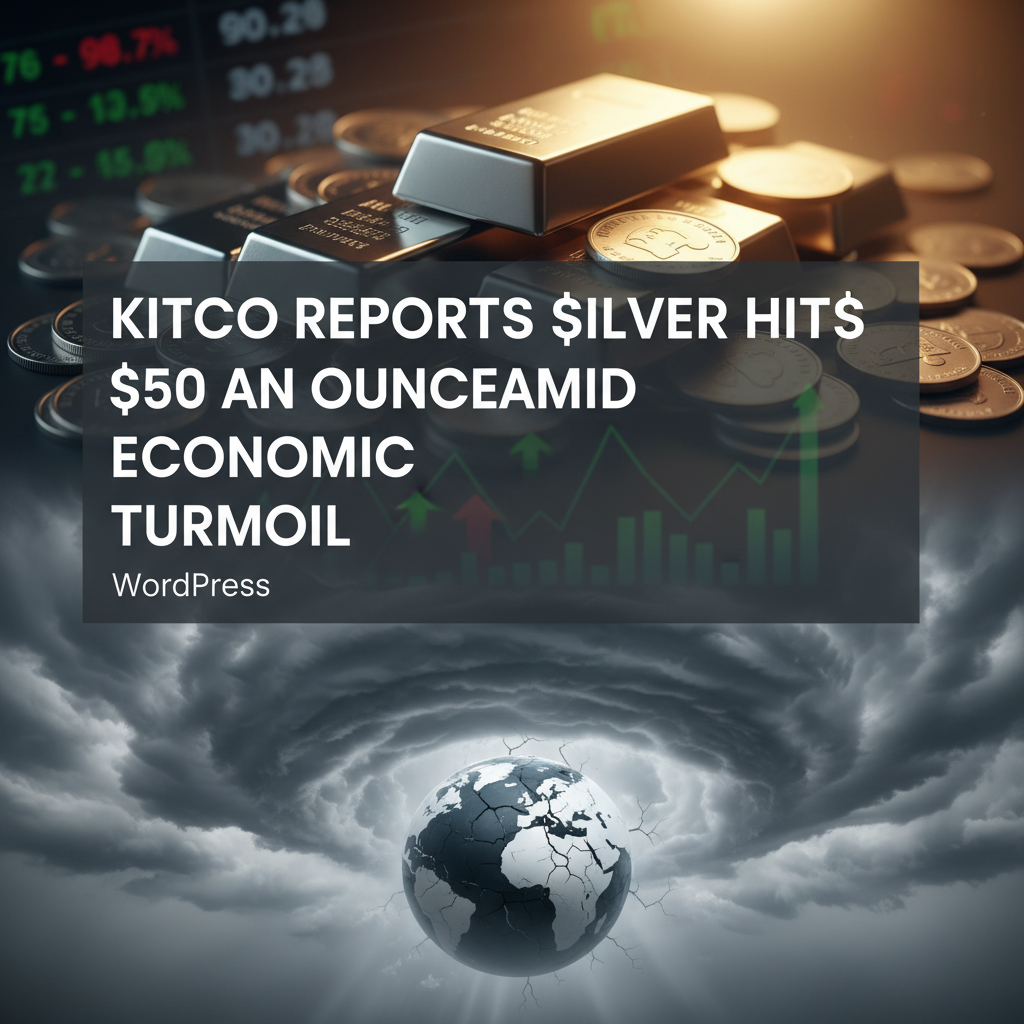Kitco Reports Silver Hits $50 an Ounce Amid Economic Turmoil
Estimated reading time: 5 minutes
- Silver surpassed $50 per ounce for the first time in history on October 9, 2025.
- Historical resistance at $50 has been broken, indicating bullish market sentiment.
- Supply deficits and increasing demand for industrial applications are key drivers.
- Geopolitical uncertainties have heightened silver’s appeal as a safe haven.
- Market forecasts suggest potential for further rallies in silver prices.
Table of Contents
- Historic Breakout of Silver Prices
- Previous Peaks
- Economic and Geopolitical Drivers Behind the Surge
- Psychological Impact and Market Sentiment
- Market Volatility Post-Breakout
- Market Forecasts: What Lies Ahead?
- Summary and Key Drivers for the Silver Market
Historic Breakout of Silver Prices
The rise in silver prices to over $50 is not merely a statistical occurrence; it is a watershed moment for the commodity. According to Kitco News, this new record price has been seen as an important psychological and technical milestone for the metal. The $50 level served as a significant ceiling during major bull markets in the past, particularly in 1980 and 2011, when silver prices reversed just below this figure, preventing a breakthrough.
Previous Peaks
Historically, silver has faced resistance at the $50 mark, reflecting the psychological barriers present in commodity trading. The peaks observed in both 1980 and 2011 serve as reminders that previous attempts to break the $50 threshold were met with substantial sell-offs. Notably, while silver briefly approached these levels, it fell back each time, confirming the resistance until now.
The inflation-adjusted records show that the 1980 peak would equate to approximately $199 today (in 2025 dollars), while the 2011 peak would be around $72. This comparative analysis indicates that despite the nominal surge to $50, the real purchasing power of silver is still below historical extremes, suggesting significant room for growth if current conditions persist.
Economic and Geopolitical Drivers Behind the Surge
Several intersecting factors have prompted this remarkable rise in silver prices:
Persistent Supply Deficit
Industry analysis indicates a substantial supply shortfall, particularly as the demand for industrial applications rises. Solar panels and electric vehicles, integral to the transition toward renewable energy, are driving increased industrial use of silver, thereby intensifying the demand scenario in the face of persistent supply constraints. A detailed look into these dynamics can be found at Investing News.
Inflation and Recession Fears
The current economic environment has led to heightened inflation and fears of a recession, pushing investors toward safer assets. As detailed by Hero Bullion, safe-haven demand has soared due to concerns over global financial stability. With gold also racing past $4,000/oz, the dual availability of these precious metals as hedges against economic uncertainty has shifted market sentiments.
Geopolitical Instability
Recent geopolitical crises have compounded uncertainties, further solidifying the position of silver as a safe investment vehicle. The interconnectedness of global markets means that shifts in geopolitical climates have immediate effects on asset prices, with investors increasingly turning to precious metals for protection.
Psychological Impact and Market Sentiment
The breaking of the $50 threshold is projected to trigger waves of investor interest, both from seasoned investors who have been waiting since the 2011 peak and from younger, new investors exploring the precious metals market for the first time. According to analysts, this creates a “virtuous cycle,” potentially pushing prices even higher as market sentiment remains bullish. Analysts’ opinions, like those found in Kitco’s opinion pieces, highlight that the psychological boundary of $50 has often acted as a major resistance point, but its breach signals a new positive era for silver prices.
Market Volatility Post-Breakout
Following the surge above $50, markets have indeed experienced typical profit-taking and price volatility. It is not uncommon for investors to capitalize on quick gains immediately following significant technical milestones. For further insights on post-breakout market action, you can refer to additional reports on Kitco, such as their coverage on profit-taking pressures. Despite this initial volatility, the underlying sentiment remains overwhelmingly positive, bolstered by long-term supply and demand fundamentals.
Market Forecasts: What Lies Ahead?
Looking forward, many analysts remain optimistic about the path for silver prices. The consensus is that as long as supply shortages persist and macroeconomic risks are elevated, there is potential for further rallies. Market forecasts suggest that if the recent trends continue, we could see unprecedented heights for silver in the coming months and years.
Moreover, the establishment of $50 as a new baseline could attract institutional investors and large funds previously hesitant about entering the market. By entering this new price era, silver might well follow the trajectory of gold, solidifying its place as a cornerstone of investment portfolios.
Summary and Key Drivers for the Silver Market
| Factor | 2025 Context |
|---|---|
| Nominal price | Surpassed $50/oz—first time ever |
| Previous attempts | 1980 and 2011; both failed just below $50 |
| Inflation-adjusted record | 1980 peak ≈ $199 (2025 dollars), 2011 peak ≈ $72 (2025 dollars) |
| Main drivers | Supply deficit, safe-haven demand, industrial (solar/EV) use, recession fear |
| Market psychology | New positive era; likely to attract new investors, increase momentum |
| Post-breakout market action | Volatility and profit-taking, but overall bullish sentiment |
In closing, silver’s recent breakthrough above $50 per ounce is indicative of larger economic patterns and investor sentiment. The evolution of precious metal prices reflects broader economic trends, underscoring the vital role that silver plays as both an industrial commodity and a safe haven. Given the market’s current trajectory, it will be exhilarating to observe how this crucial milestone influences investment patterns and the broader financial landscape.
For more trending news, visit NotAIWorld.com.
